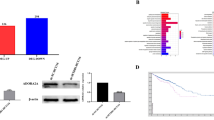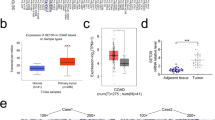Abstract
Background/Aims
Altered Recepteur d’Origine nantais (RON) expression transduces signals inducting invasive growth phenotype that includes cell proliferation, migration, matrix invasion, and protection of apoptosis in human cancer cells. The aims of the current study were to evaluate whether RON affects tumor cell behavior and cellular signaling pathways including activator protein-1 (AP-1) and Akt/forkhead box O (FoxO) in human colorectal cancer cells.
Methods
To study the biological role of RON on tumor cell behavior and cellular signaling pathways in human colorectal cancer, we used small interfering RNA (siRNA) to knockdown RON gene expression in human colorectal cancer cell line, DKO-1.
Results
Knockdown of RON diminished migration, invasion, and proliferation of human colorectal cancer cells. Knockdown of RON decreased AP-1 transcriptional activity and expression of AP-1 target genes. Knockdown of RON activated cleaved caspase-3, -7, -9, and PARP, and down-regulated the expression of Mcl-1, survivin and XIAP, leading to induction of apoptosis. Knockdown of RON induced cell cycle arrest in the G2/M phase of cancer cells by an increase of p27 and a decrease of cyclin D3. Knockdown of RON inhibited the phosphorylation of Akt/FoxO signaling proteins such as Ser473 and Thr308 of Akt and FoxO1/3a.
Conclusions
These results indicate that knockdown of RON inhibits AP-1 activity and induces apoptosis and cell cycle arrest through the modulation of Akt/FoxO signaling in human colorectal cancer cells.






Similar content being viewed by others
References
Lu Y, Yao HP, Wang MH. Multiple variants of the RON receptor tyrosine kinase: biochemical properties, tumorigenic activities, and potential drug targets. Cancer Lett. 2007;257:157–164.
Leonis MA, Thobe MN, Waltz SE. Ron-receptor tyrosine kinase in tumorigenesis and metastasis. Future Oncol. 2007;3:441–448.
Camp ER, Liu W, Fan F, Yang A, Somcio R, Ellis LM. RON, a tyrosine kinase receptor involved in tumor progression and metastasis. Ann Surg Oncol. 2005;12:273–281.
Wang MH, Yao HP, Zhou YQ. Oncogenesis of RON receptor tyrosine kinase: a molecular target for malignant epithelial cancers. Acta Pharmacol Sin. 2006;27:641–650.
Wang MH, Wang D, Chen YQ. Oncogenic and invasive potentials of human macrophage-stimulating protein receptor, the RON receptor tyrosine kinase. Carcinogenesis. 2003;24:1291–1300.
Wagh PK, Peace BE, Waltz SE. Met-related receptor tyrosine kinase Ron in tumor growth and metastasis. Adv Cancer Res. 2008;100:1–33.
Danilkovitch-Miagkova A. Oncogenic signaling pathways activated by RON receptor tyrosine kinase. Curr Cancer Drug Targets. 2003;3:31–40.
Lee CT, Chow NH, Su PF, Lin SC, Lin PC, Lee JC. The prognostic significance of RON and MET coexpression in patients with colorectal cancer. Dis Colon Rectum. 2008;5:1268–1274.
Maggiora P, Marchio S, Stella MC, et al. Overexpression of the RON gene in human breast carcinoma. Oncogene. 1998;16:2927–2933.
Willett CG, Wang MH, Emanuel RL, et al. Macrophage-stimulating protein and its receptor in non-small cell lung tumors: induction of receptor tyrosine phosphorylation and cell migration. Am J Respir Cell Mol Biol. 1998;18:489–496.
Maggiora P, Lorenzato A, Fracchioli S, et al. The RON and MET oncogenes are co-expressed in human ovarian carcinomas and cooperate in activating invasiveness. Exp Cell Res. 2003;288:382–389.
Cheng HL, Liu HS, Lin YJ, et al. Coexpression of RON and MET is a prognostic indicator for patients with transitional-cell carcinoma of the bladder. Br J Cancer. 2005;92:1906–1914.
Matthews CP, Colburn NH, Young MR. AP-1 a target for cancer prevention. Curr Cancer Drug Targets. 2007;7:317–324.
Shaulian E. AP-1-The Jun proteins: oncogenes or tumor suppressors in disguise? Cell Signal. 2010;22:894–899.
Ozanne BW, Spence HJ, McGarry LC, Hennigan RF. Transcription factors control invasion: AP-1 the first among equals. Oncogene. 2007;26:1–10.
Dong Z, Birrer MJ, Watts RG, Matrisian LM, Colburn NH. Blocking of tumor promoter-induced AP-1 activity inhibits induced transformation in JB6 mouse epidermal cells. Proc Natl Acad Sci USA. 1994;91:609–613.
Young MR, Li JJ, Rincón M, et al. Transgenic mice demonstrate AP-1 (activator protein-1) transactivation is required for tumor promotion. Proc Natl Acad Sci USA. 1999;96:9827–9832.
Yang JY, Hung MC. A new fork for clinical application: targeting forkhead transcription factors in cancer. Clin Cancer Res. 2009;15:752–757.
Finlay D, Cantrell D. Phosphoinositide 3-kinase and the mammalian target of rapamycin pathways control T cell migration. Ann N Y Acad Sci. 2010;1183:149–157.
Reagan-Shaw S, Ahmad N. The role of Forkhead-box Class O (FoxO) transcription factors in cancer: a target for the management of cancer. Toxicol Appl Pharmacol. 2007;224:360–368.
Lam EW, Francis RE, Petkovic M. FOXO transcription factors: key regulators of cell fate. Biochem Soc Trans. 2006;34:722–726.
Ito K, Bernardi R, Pandolfi PP. A novel signaling network as a critical rheostat for the biology and maintenance of the normal stem cell and the cancer-initiating cell. Curr Opin Genet Dev. 2009;19:51–59.
Vaiopoulos AG, Papachroni KK, Papavassiliou AG. Colon carcinogenesis: learning from NF-kappaB and AP-1. Int J Biochem Cell Biol. 2010;42:1061–1065.
Raff MC. Social controls on cell survival and cell death. Nature. 1992;356:397–400.
Mason EF, Rathmell JC. Cell metabolism: an essential link between cell growth and apoptosis. Biochim Biophys Acta. 2011;1813:645–654.
DeBerardinis RJ, Lum JJ, Hatzivassiliou G, Thompson CB. The biology of cancer: metabolic reprogramming fuels cell growth and proliferation. Cell Metab. 2008;7:11–20.
Morgan DO. Principles of CDK regulation. Nature. 1995;374:131–134.
Grana X, Reddy EP. Cell cycle control in mammalian cells: role of cyclins, cyclin dependent kinases (CDKs), growth suppressor genes and cyclin-dependent kinase inhibitors (CKIs). Oncogene. 1995;11:211–219.
Johnson N, Shapiro GI. Cyclin-dependent kinases (cdks) and the DNA damage response: rationale for cdk inhibitor-chemotherapy combinations as an anticancer strategy for solid tumors. Expert Opin Ther Targets. 2010;14:1199–1212.
Song G, Ouyang G, Bao S. The activation of Akt/PKB signaling pathway and cell survival. J Cell Mol Med. 2005;9:59–71.
Li Z, Yao H, Guin S, Padhye SS, Zhou YQ, Wang MH. Monoclonal antibody (mAb)-induced down-regulation of RON receptor tyrosine kinase diminishes tumorigenic activities of colon cancer cells. Int J Oncol. 2010;37:473–482.
Wang MH, Lao WF, Wang D, Luo YL, Yao HP. Blocking tumorigenic activities of colorectal cancer cells by a splicing RON receptor variant defective in the tyrosine kinase domain. Cancer Biol Ther. 2007;6:1121–1129.
Baba Y, Nosho K, Shima K, et al. Phosphorylated AKT expression is associated with PIK3CA mutation, low stage, and favorable outcome in 717 colorectal cancers. Cancer. 2011;117:1399–1408.
McNamara CR, Degterev A. Small-molecule inhibitors of the PI3K signaling network. Future Med Chem. 2011;3:549–565.
Kousteni S. FoxO1: a molecule for all seasons. J Bone Miner Res. 2011;26:912–917.
Myatt SS, Brosens JJ, Lam EW. Sense and sensitivity: FOXO and ROS in cancer development and treatment. Antioxid Redox Signal. 2011;14:675–687.
Zanella F, Carnero A. Adding more content to screening: reactivation of FOXO as a therapeutic strategy. Clin Transl Oncol. 2009;11:651–658.
Maiese K, Chong ZZ, Hou J, Shang YC. The “O” class: crafting clinical care with FoxO transcription factors. Adv Exp Med Biol. 2009;665:242–260.
Acknowledgments
This work was supported by a grant from the Korea Science & Engineering Foundation through the Medical Research Center for Gene Regulation (R13-2002-013-06002-0) at Chonnam National University, Republic of Korea, and partly by a grant (0720570) from the National R&D Program for Cancer Control, Ministry of Health & Welfare, Republic of Korea.
Conflict of interest
None declared.
Author information
Authors and Affiliations
Corresponding author
Additional information
Cho-Yun Chung and Young-Lan Park contributed equally to this work.
Rights and permissions
About this article
Cite this article
Chung, CY., Park, YL., Song, YA. et al. Knockdown of RON Inhibits AP-1 Activity and Induces Apoptosis and Cell Cycle Arrest Through the Modulation of Akt/FoxO Signaling in Human Colorectal Cancer Cells. Dig Dis Sci 57, 371–380 (2012). https://doi.org/10.1007/s10620-011-1892-7
Received:
Accepted:
Published:
Issue Date:
DOI: https://doi.org/10.1007/s10620-011-1892-7




